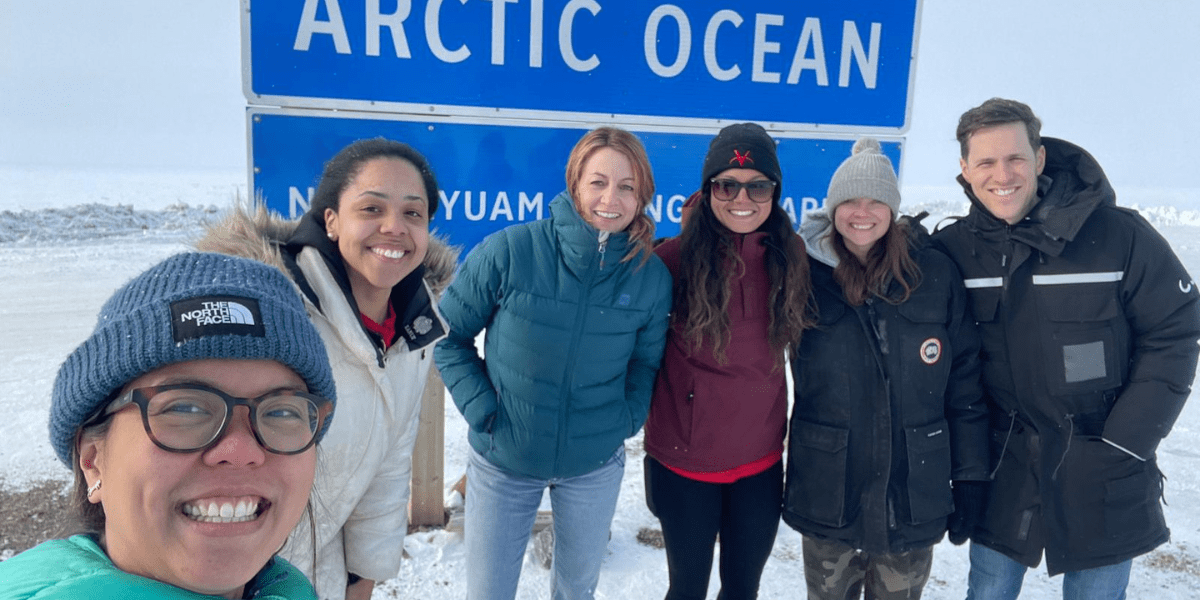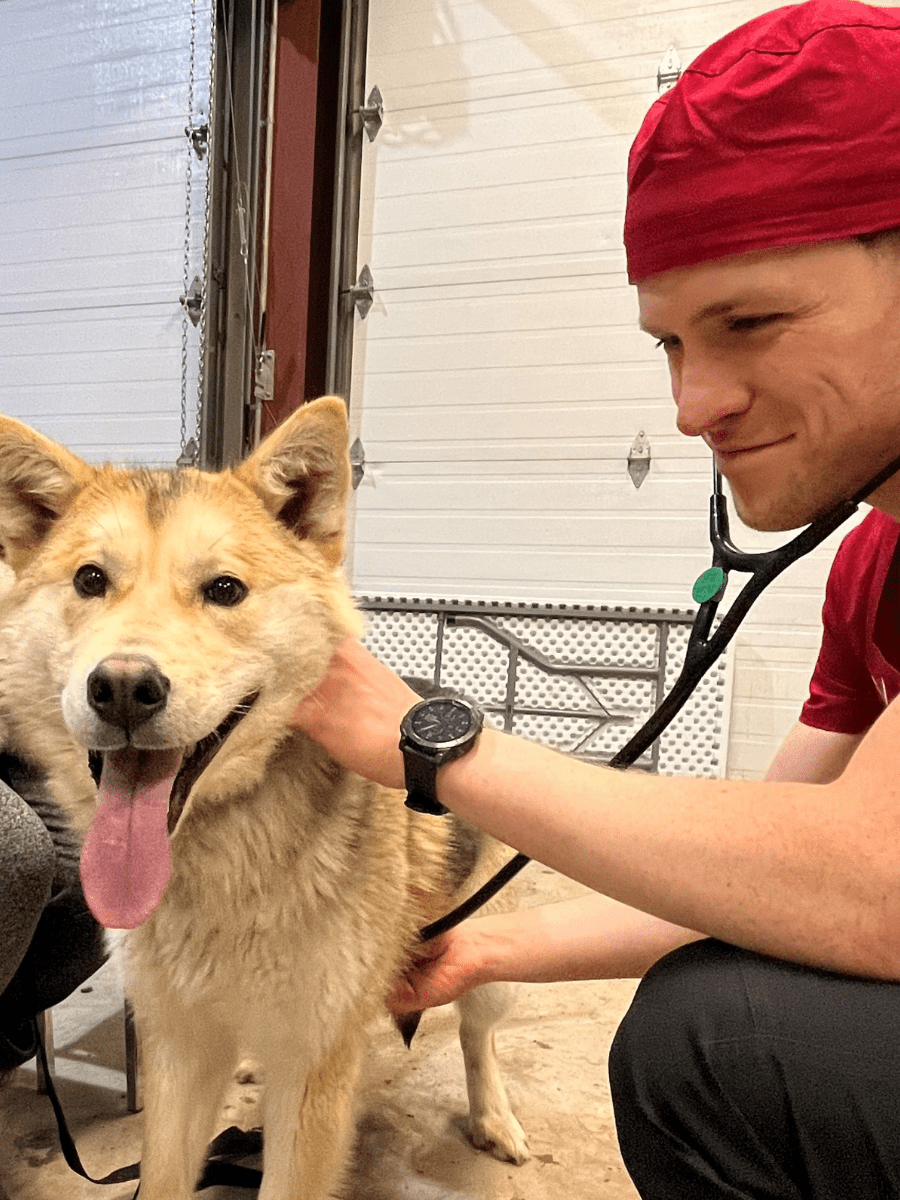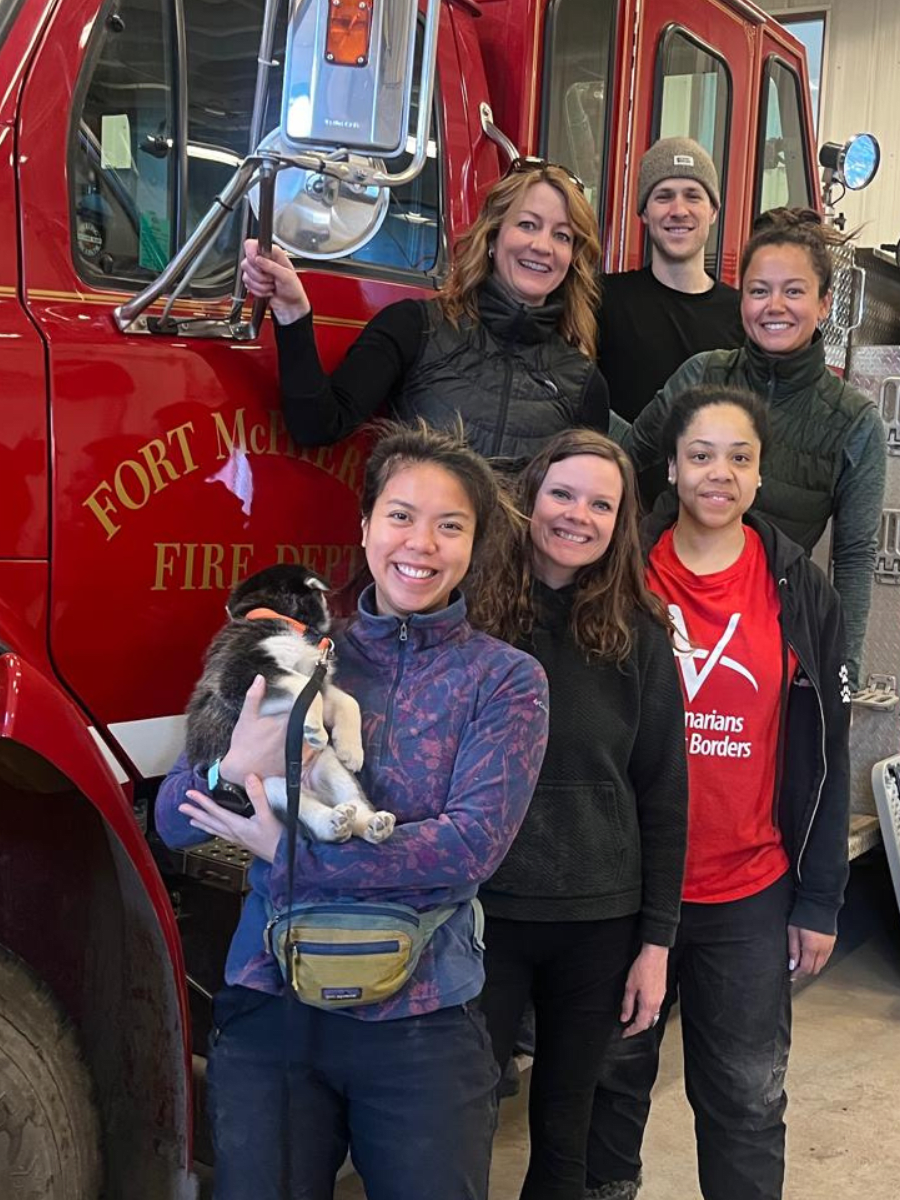At Veterinarians Without Borders North America (VWB), our team members and volunteers are often on the frontlines of building capacity for animal health through trainings and other veterinary services aimed at keeping animals and communities as healthy as possible. Because of this incredible and varied community of voices, VWB has launched 'Ask an Expert' — a blog dedicated to featuring community members and their varying experiences in the animal health space.

Spring clinic 2024 NAHI team. Pictured from L-R: Dr. Kim Castro (DVM), Genevieve Douyon (RVT/VWB), Rebecca Stevens (RVT), Dr. Michelle Tuma (DVM/VWB), Jennifer Nowell (RVT), Dr. Doug Doyle-Baker (DVM).
In this edition of 'Ask an Expert', we chatted with Dr. Doug Doyle-Baker (DVM), a practicing veterinarian in Toronto, Ontario, who this past spring spent time volunteering with VWB's Northern Animal Health Initiative (NAHI) in the Northwest Territories.
Joining the team to visit two remote communities — Tuktoyaktuk and Fort McPherson, Dr. Doyle-Baker shared his experiences while visiting the North with VWB and ideas for building sustainable veterinary care in northern Canada.

Q: Can you describe your time spent volunteering with VWB's NAHI program?
A: This was my third time going to the Northwest Territories, but my first time going with VWB. It’s quite a journey to get there from Toronto – I used to live in Calgary so it was less of a journey. I flew from Toronto to Edmonton, Edmonton to Yellowknife, and then we flew to Inuvik. We drove to Tuktoyaktuk, which is a really cool drive through the tundra. It was always something that I wanted to do. I’d been to Inuvik before but never further north than that.
Going to Tuk was a dream. I got to see the Arctic Ocean, which was really cool. It’s just this vast expanse of frozen ice. We set up our clinic the day we arrived. [Once the clinic got going], we did a lot of spays and neuters, wellness exams, and vaccinations. I think people [in Tuktoyaktuk] have come to expect VWB coming once a year, so people were expecting us and wanted to have various animal health questions answered.
We were in Tuk for three days, packed everything up, and then went on the highway south to Fort McPherson, which was also my first time there. It was really quite interesting seeing the weather difference at that time of year. Tuk was quite cold, -20, then in Fort McPherson it was plus 10 and very, very warm and spring-like. Someone there told us they call this "mud season". We set up there and did two days; our surgery schedule was even busier than in Tuk. We did a lot of of wellness exams and vaccinations. In both communities, we did house calls, including various house calls to sled dogs.
Q: In your opinion, what are the most critical resources or support systems needed in these remote communities to improve access to animal health care?
A: I think the biggest determinant of success in each community is having, what I could call, a community champion. This is someone in the community who is keen on the mission of improving animal health. I think we had that in both communities; community members who were very keen on seeing the health of dogs improve and ensuring they had access to care. A few people in Tuk, and in Fort McPherson a woman named Carol who is a nurse there, were very passionate about animal health. Of course, access to resources and supplies is also very important.
Q: How do you envision the future of access to animal health care in the North?
A: My hope is that things will continue to improve and that people in power and people with money will notice the good work that VWB is doing and help to fund these initiatives. And finding [more] ways to make veterinary care sustainable in the North. Ultimately, it is a One Health thing. If we have healthy animals, we hope to have healthy people and a healthy environment, too.
Q: What's something new you learned while on your volunteer placement?
A: Doing the house calls is always really cool and seeing how sled dogs are very much a working animal and dearly loved by their owners and guardians. [Also seeing] how much work and effort goes into caring for them, especially the amount of food these dogs require. They are outdoor dogs and it takes a lot of energy to keep warm throughout the winter and keep fit and strong to do their job in the North. It was just something really cool to learn about. In Tuk, we visited some dogs that eat a lot of fish because the community is right on the ocean. [The community] does a lot of fish harvesting for both people and dogs, and seeing that whole process [was very interesting]. They harvest fish during the summer and keep it all frozen, and then heat it up and gave it to the dogs.
One fun part [of attending the clinics] is going to the local schools and speaking with the young people. Two of my team members spoke at the school in Tuk, and I went to the school in Fort McPherson. We got really good engagement from the [students]. Inspiring the youth is important for changing how people view animal health in the future.

Dr. Doyle-Baker examines a dog visiting the clinic.

The clinic team poses for a photo at the firehall in Tuktoyaktuk.
Q: What are your thoughts on ensuring continuous veterinary care for animals in communities that have limited access to care?
A: The key to building sustainable animal health in the North is building the capacity of locals to care for animals when veterinary professionals aren’t there. I got to see how VWB did the rabies lay vaccinator program, which is very cool and important. In Tuk, it was all women [lay vaccinators being trained]. They got to practice on some of the anesthetized animals as it's a safer way [for them to learn]. Expanding on lay vaccinators, further training and education could be really important and something that VWB could offer on the side (e.g., first aid for dogs). Training for people to be able to tend to certain things when there are no veterinarians available. Also, VWB partnered with Animal HealthLink to provide telemedicine in the North, which is really great. Telemedicine can go a long way, I think.
Q: Can you share a memorable experience?
I really loved the team I was with. It’s so cool to be essentially thrown into a team and you don’t know any of the people you’re with. You create a strong bond with them and everyone was keen to pitch in whenever necessary. It was such a great part of the experience, knowing people from different parts of Canada who I will hopefully meet again.
I mentioned Carol earlier. Just hearing her stories of her time in Fort McPherson and [how things have changed]. Hearing stories of how things have improved for the animals and communities was really cool.
Q: Any words of advice for potential volunteers?
I think for people who are considering volunteering with NAHI, they need to be ready to be a bit uncomfortable and challenged. This is not a luxury trip; they must be prepared for that. Doing some research and reading and leg work on the front end [is also important]. Looking into cultural competency is a big thing. Because we’re going to communities where Indigenous people live, looking into cultural context with Indigenous people is important. Questioning your biases is also important. Also being prepared that it’s a spectrum of care – we have to meet people where they’re at and make due with what we have.

This Giving Tuesday, you can have a real, life-saving impact by helping to purchase essential veterinary equipment like blood pressure monitors, vaccines, sterilization kits and surgical tools for our no-cost temporary veterinary clinics in remote Northern communities.
Every gift you make will be MATCHED* having DOUBLE the impact for companion animals ensuring they stay healthy and happy.
*Donations will be matched up to $10,000 until Tuesday, December 3, 2024, at 12 midnight EST thanks to our generous match partners.





